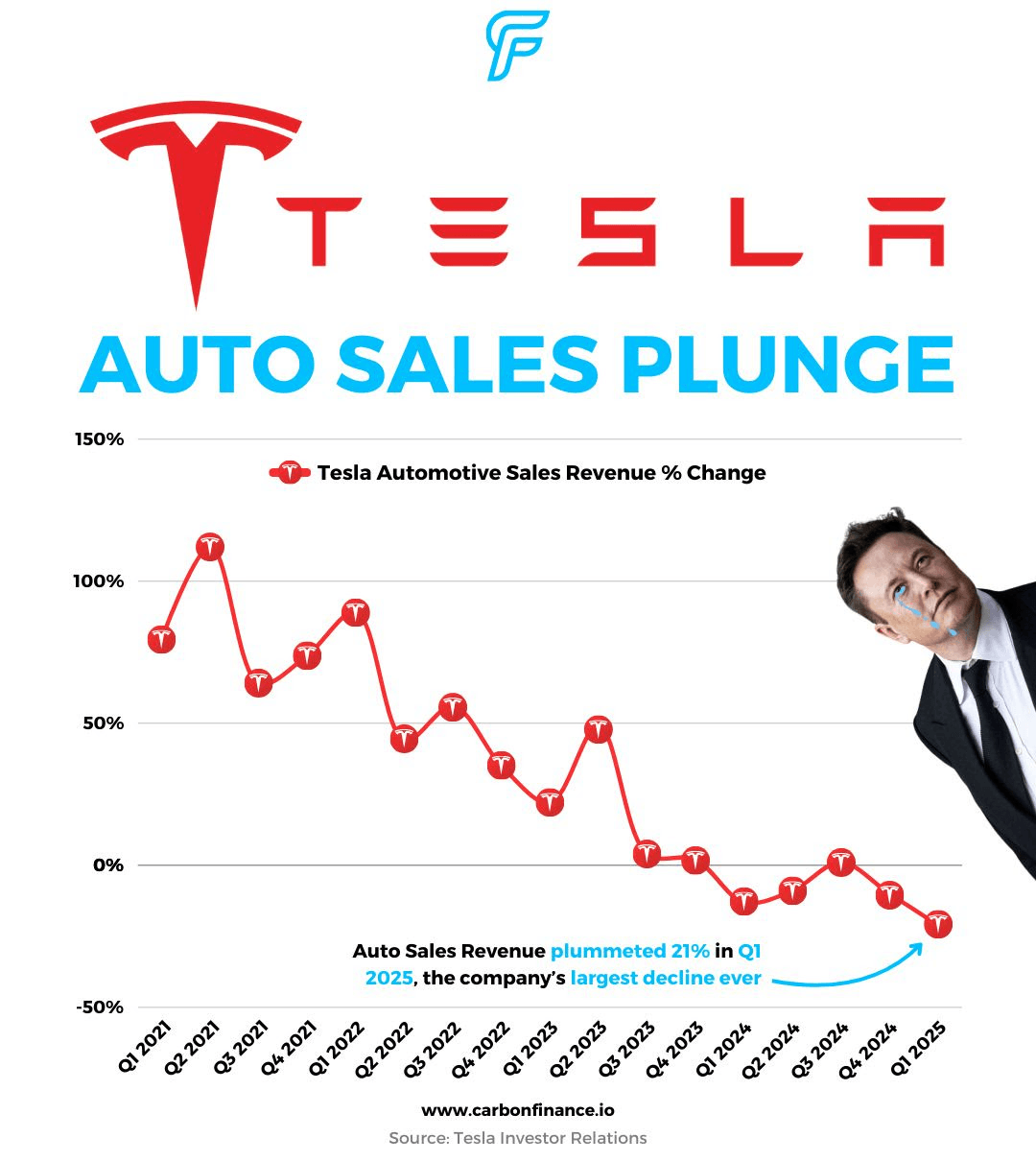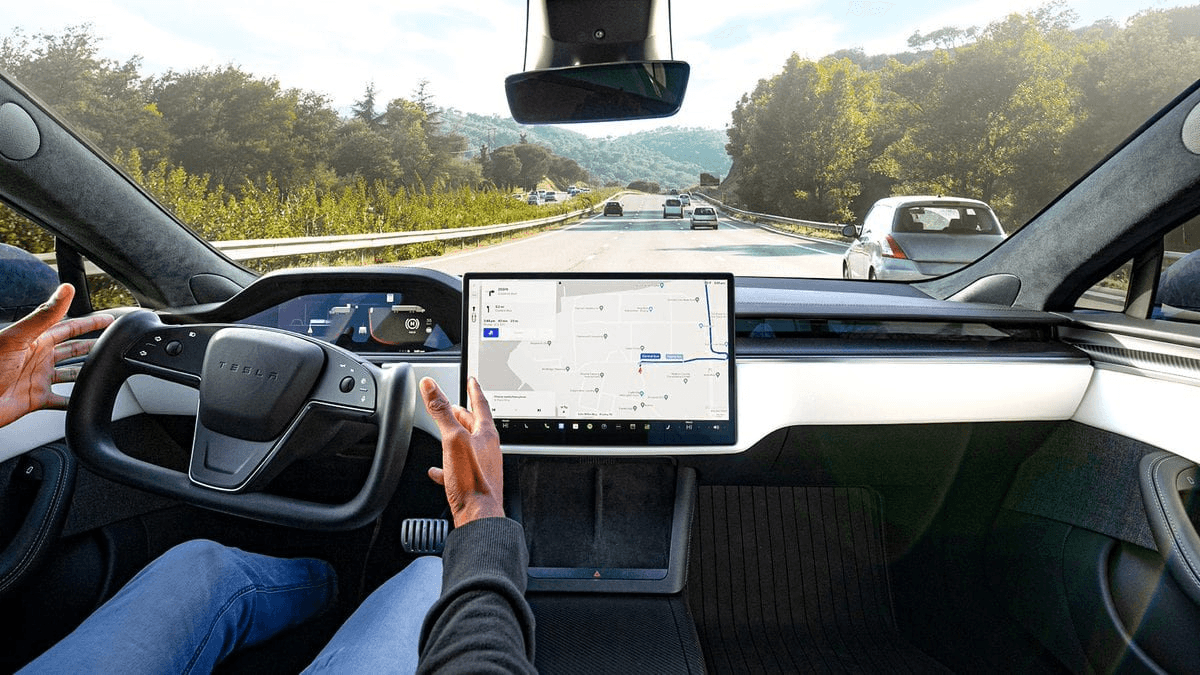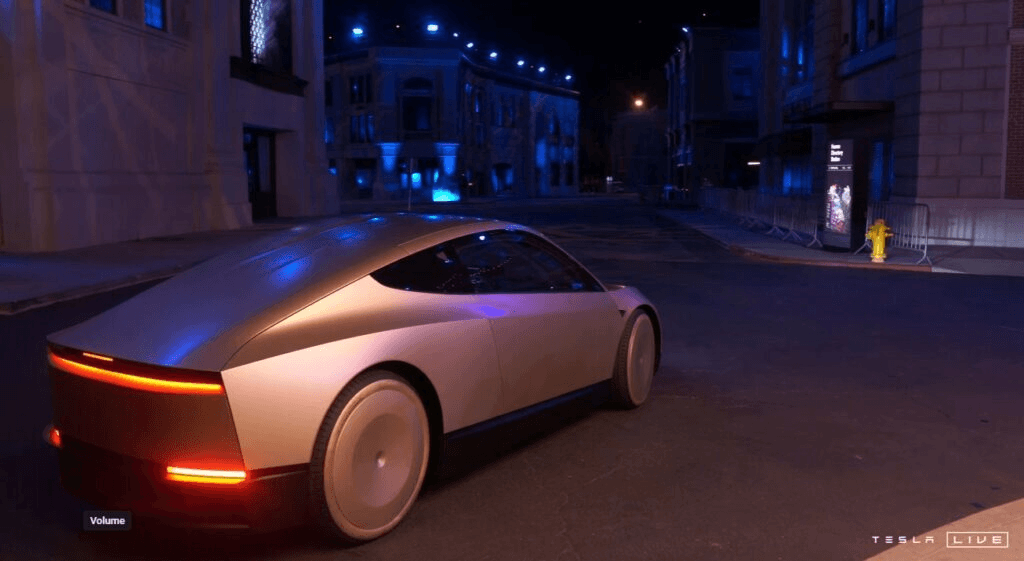Why did smart money bet on Tesla when the stock price was halved and the financial report collapsed?

RockFlow Shayne
May 15, 2025 · 11 min read

Highlight:
1)Despite Tesla's Q1 revenue falling 9% YoY and earnings per share lower than expected by 40%, the stock price rebounded 30% in two weeks. The market has digested pessimistic expectations in advance, focusing on new growth points such as autonomous driving and robotics after oversold conditions, reflecting investors' bets on long-term technology dividends. 2) Tesla FSD daily average road test reaches 10 million miles, 50 times more than Waymo, massive real data drive AI iteration. Cybercab Austin pilot in June will verify the pure visual solution, 30,000 the cost of a bicycle + policy relaxation or open the trillion-dollar travel market subversion. 3)The RockFlow research team believes that Tesla's darkest hour has passed, and Optimus mass production and FSD monetization constitute a double-click opportunity. 2026 may become the critical point for the scale of autonomous driving, and the long-term outlook is optimistic about its competitive barriers of data + vertical integration.
Tesla's latest quarterly financial report released at the end of April: revenue decreased by 9% year-on-year, car sales decreased by 20% year-on-year, and earnings per share were nearly 40% lower than expected. Even Musk's most loyal supporters have to agree that this financial data is "a disaster".
Despite the poor financial report, Tesla's stock price has rebounded significantly in the past two weeks, rising by 30%.
After months of working in the White House, Musk now says he will reduce investment in the Department of Government Effectiveness (DOGE) and refocus on Tesla. He also promises to work hard to reduce tariffs.
Tesla's bulls are currently most concerned about the progress of its autonomous driving business, with two important signals:
RoboTaxi will launch in Austin this summer, and Tesla's cost is expected to surpass Waymo's. Regulatory support for autonomous driving has finally arrived, paving the way for the development of RoboTaxi.
At the earnings conference, Musk also introduced the latest progress of Tesla's humanoid robot Optimus. He expects that at least thousands of Optimus will be put into use in Tesla factories by the end of 2025, with the goal of achieving an annual production 1 million within five years.
Simply put, Tesla is doubling down on autonomous driving and robotics as the next big growth engine to recast its tech company base color.
RockFlow's investment research team believes that Tesla's most difficult period may have passed. With the upcoming launch of new products, Musk is back on track. Coupled with the significant decline in Tesla's stock price this year, it is currently a cost-effective position, and its future development is worth looking forward to.
Unimpressive financial reports and Musk's sincerity
Tesla's quarterly financial report data was dismal, but why did the stock price still rise by 30% two weeks after the report was released? Everything depends on expectations.
Earlier this year, Tesla's stock price fell nearly 40%, which was actually the result of the market digesting its poor Quarter 1 revenue data in advance.
Here is some key data for Quarter 1 in 2025:
Adjusted earnings: $0.27 (down 40% year-on-year), far below the expected $0.39
Revenues: $19.34 billion (down 9%), expected $21.11 billion
Total automotive revenue: $14 billion (down 20%)
Energy production and storage revenue: $2.70 billion (up 67%)
Operating profit: $399 million (down 66%)
Operating margin: 2.1% (down 343 basis points)
Cash and cash equivalents: $37 billion (up 38%)

Tesla's 2025 Quarter 1 revenue has reached its lowest level in nearly three years. Investors are concerned that although it is investing heavily in innovative projects (such as self-driving taxis and humanoid robots), it still faces the same pressure as traditional car manufacturers. In addition, constantly changing trade policies are causing uncertainty in the global supply chain, which may affect its costs.
Fortunately, during the earnings call, Musk timely released good news to reassure people - he plans to reduce his focus on DOGE and focus more on Tesla's business.
Shortly thereafter, the US Department of Transportation also sent good news that US companies developing autonomous cars will be allowed to exempt certain federal safety rules. The department will also simplify collision reporting requirements involving autonomous driving software (which Musk criticized as too onerous), and will move towards developing a national set of autonomous driving technology rules to replace the chaotic regulations of each state.
At almost the same time, Musk confirmed that Tesla will launch self-driving Tesla taxis in Austin, Texas in June.
Why does Tesla's autonomous driving advantage surpass others?
Musk's previous massive layoffs and pointing fingers at other governments (publicly supporting the far-right party Alternative for Germany and calling for the overthrow of the Labour government in the United Kingdom) have damaged Tesla's brand perception in multiple markets. However, it cannot be denied that Tesla's ambitions in the field of autonomous driving, especially its fully autonomous driving platform (FSD) and the upcoming Cybercab, are still favored by bulls.
Its unparalleled data advantage and the huge addressable market for self-driving taxis will clearly determine the company's future more than Musk's current public image.
In June of this year, Tesla's long-promised autonomous driving strategy is about to reach a key milestone: Tesla is preparing to launch a self-driving ride-hailing service called "Cybercab" in Austin, Texas.
Although this is only the first step, Tesla cars will drive on city streets for the first time without a human driver in the front seat - which may mark a critical transition phase for Tesla from testing autonomous driving technology to commercial deployment.
Tesla's fully autonomous driving (FSD) platform has developed rapidly in the past year. Internal reports indicate that the "intervention interval mileage" of its FSD software (installed on hundreds of thousands of customer vehicles) has significantly improved - an important indicator aimed at measuring how far a car can travel in autonomous driving before it must be taken over by humans.

Although competitors like Waymo have made headlines by providing fully autonomous driving services within limited city geo fencing, Tesla has been accumulating massive amounts of real-world driving data. According to Alphabet, as of February 2025, Waymo's commercial autonomous taxi fleet had about 200,000 miles of autonomous driving mileage per day. In contrast, Tesla's FSD has about 10 million miles of autonomous driving or assisted mode per day in a wider range of road and road conditions.
In other words, before launching its self-driving taxi service, Tesla had about 50 times the data advantage over Waymo in terms of actual driving experience. This massive amount of driving data, covering various extreme situations, weather, and road types, will form the core competitiveness of Tesla's constantly improving AI driving model.
In the AI era, data itself is a new gold mine. Tesla is using the largest real driving dataset on Earth to effectively solve the problem of autonomous driving. Once true unmanned driving operations begin, faster iteration and improvement will be achieved.
Musk believes that Tesla's pure vision solution (using cameras instead of lidar) is feasible because neural networks trained after billions of miles of driving can ultimately handle extreme situations on par with or even better than specialized sensors. The upcoming test in Austin will prove it.
It is worth noting that Tesla's strategy has undergone subtle changes. For years, Musk has promised that existing Tesla cars will become self-driving taxis "overnight" through software updates. However, in reality, achieving full L4/L5 level autonomous driving is much more difficult than expected. Tesla is currently implementing its strategy by forming dedicated fleets (similar to Waymo and Cruise).
Cybercab's launch event at the end of 2024 revealed that Cybercab is a compact two-seater electric vehicle designed specifically for autonomous driving and ride-hailing services. It features a hyper-streamlined design with only 80 structural components (while Model Y contains over 200), allowing for low-cost mass production - according to Tesla's disclosure in October 2024, the cost of each Cybercab will be less than $30,000.
By deploying Cybercabs equipped with geo fencing and remote monitoring in a city, Tesla can verify fully autonomous driving in a relatively safe environment and then operate on a large scale. This is completely different from relying solely on customers to test on public roads, indicating that Tesla's strategy is becoming increasingly mature.
As for the effect, the autonomous driving test service that Cybercabs will launch on the streets of Austin in June will tell us the answer.
Future Potential of FSD and "Robotaxi"
In the short term, the RockFlow research team is cautiously optimistic about Tesla's partial self-driving "promotion". Musk's schedule has always been known for optimism, but it seems that Tesla is indeed confident in launching the self-driving taxi Cybercab this year. Moreover, Tesla is increasing remote human monitoring to ensure safety - they have hired remote operators who can monitor self-driving taxis and intervene remotely when the vehicle malfunctions.
Essentially, Tesla is doing something similar to Waymo and Cruise (remote human monitoring), but if the pilot in Austin goes well, it may expand this service to other cities and eventually cancel remote monitoring.
The economic opportunity behind Tesla's push for self-driving taxi business is huge. By transforming cars into software-driven revenue-generating tools, Tesla is expected to completely change the business model of transportation. Self-driving taxis are no longer just selling cars once, but earning tens of thousands of dollars in revenue annually through continuous service.

Importantly, the addressable market is huge in terms of global consumer spending on transport - research by several investment banks suggests that trillions of dollars of economic redistribution can be attributed to the shift towards automation in transport.
This is why Tesla sees autonomous driving as an important business direction for the next few decades. In a previous earnings call, Musk even boasted that Tesla's autonomous taxi network, combined with its humanoid robots, could make Tesla the world's most valuable company.
Tesla's Austin pilot project will start in June this year, with limited service areas and a fleet of company-owned vehicles (initially including modified Model Y and early Cybercab prototypes). With the expansion of monetization scale, the improvement of utilization rate, and the reduction of human drivers (and their labor costs), the long-term cost curve will show a downward trend. In this way, Tesla is expected to achieve a healthy "take rate" on each trip, continue to weaken competitors, and maintain long-term competitive advantages.
In short, Tesla's FSD platform is entering the verification period. Basic work such as data, AI capabilities, and vehicle design is sufficient to lay the foundation for true autonomous driving services.
Conclusion
When will autonomous driving truly achieve scale? The RockFlow research team believes that a critical turning point is happening. Just like the launch of the internet or smartphones, the popularity of autonomous cars may seem gradual, but at some point it will make rapid progress. We expect Tesla to start small in Austin, collect feedback, and then quickly iterate its software. If everything goes smoothly, by 2026, Tesla may operate autonomous driving fleets in multiple cities in the US.
Given Tesla's addressable market size reaching trillions of dollars, it has strong competitive barriers (massive data, vertical integration, and unit economic benefits) and an attractive value proposition (cheaper and safer transportation options). The RockFlow research team has long been optimistic about Tesla's value.
This is the dawn of the Cybercab era and may also be the beginning of a revolution in the way humans travel.
Related Content



